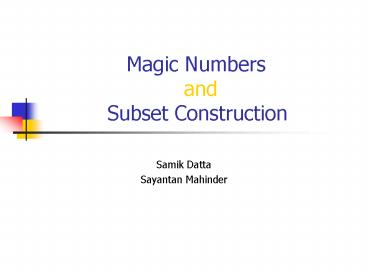Magic Numbers and Subset Construction - PowerPoint PPT Presentation
1 / 15
Title:
Magic Numbers and Subset Construction
Description:
Iwama, Matsuura, Paterson defined a magic number as an integer ... various operations like Reversal, Shuffle, Quotient, Prefix etc. on those regular languages. ... – PowerPoint PPT presentation
Number of Views:65
Avg rating:3.0/5.0
Title: Magic Numbers and Subset Construction
1
Magic Numbers
and Subset Construction
- Samik Datta
- Sayantan Mahinder
2
Magic Number, a
- Iwama, Matsuura, Paterson defined a magic number
as an integer a between n and (both
inclusive) such that there is no minimal NFA of n
states which require exactly a states in the
minimal equivalent DFA. - We know that n and are not magic
numbers. - Why? The division automaton, the DFA for the
(n-1)th symbol from the RHS is 0. - We will investigate the question, whether
,in particular, is a magic number? More
optimistically are there any magic numbers at
all?
3
Fooling Set for language L
- Fooling set (pair of strings) satisfies the
following 2 conditions - 1. For all k,
- 2.For all different i, j, at least one of the
followings are satisfied (cross-over terms). - Example for a fooling set is
4
Minimality of NFA
- Lemma If L is a regular language, them the of
states in a NFA accepting L is - Proof outline All the intermediate states
reached after reading the first string (of the
pair) in the fooling set are different. Prove
using contradiction. - Corollary To prove that a given NFA for L with n
states is minimal, we can demonstrate a fooling
set of cardinality n.
5
A skeleton NFA
- The NFA M has n states and have only 2
restrictions on its transition - for all
i1,2, ,n-1 - All the other transitions for the rest of the
alphabet (except 1) are arbitrary. - is the only start state, is the
only accepting state.
6
An useful theorem
- Theorem For any NFA M satisfying 1 and 2, the
following 2 facts hold good - 1. M is minimal among the NFA s accepting L(M).
- 2. The DFA consisting of the reachable states
after the subset construction is minimal, too. - Proof outline
- (1) Show a fooling set of cardinality n.
- (2) The string leads a state of the DFA
(obtained by subset construction) with as an
element to a final state and another state
without as an element to the non-final
state. Therefore, there are no 2 equivalent
states in the power set of Q which are reachable
from the start state.
7
The bound is tight!
- It is a variation of the skeleton NFA we
considered in the last slide , having 0,1 as
the alphabet, and the transitions on 0 defined as
in the figure. - Please note the back arrow, forward arrow labeled
0 from each state. What demands them to be
present?
8
But why ?
- denotes the of states in the
minimal DFA equivalent to minimal NFA M with n
states. - Proof outline To show that all the states in
P(Q) are reachable in the subset construction,
use induction on the cardinality of the set
concerned. - Basis Cardinality 0,1 All k1 such states are
reachable. - Hypothesis All states with cardinality lt l-1
are reachable. - Induction To show that all the states with
cardinality l are reachable, note that
9
Another family,
- Proof outline Use the previous result be
careful to prove that no other state is
reachable. Minimality follows from our good old
lemma.
10
Yet another family!
- Trick Take your alphabet to be big enough,
consisting of - letter, including 0,1.
- Construction start with
- Add transitions from the accepting state on
letters (none 0,1) - to the states where
each such state is of the form -
except the - Proof outline It is easy to see all the
newly added j states are reachable, but we have
to be careful to show that no other state is
reachable.
11
Magic Number is a Myth!
- The case, a n is trivial
- Else a satisfies
- In case when a is the left limit, consider
- Else consider
- If a is 2 power n, consider
12
Wait a minute what happens in small alphabet ?
- In the paper, Galina Jiraskova was able to give
the proof of no magic number using 2n sized
alphabet (unlike we did here for exponential
order). But, it is not a construction, but an
existence. - In case of 0,1, the same author proved that
there is no magic number of - But the question whether there are some magic
numbers of is still open. - In case of 1, Chrobak proved that no minimal
NFA with n states needs - states in the minimal
equivalent DFA. - The question whether there exist some magic
less than that is still open
13
Any practical implications ?
- Yes, these bounds are necessary to analyze the
algorithms involving the finite automata - There is a field called the state complexity
theory, which gives lower bound for minimum
number of states needed to recognize certain
regular languages, and other regular languages
obtained by applying various operations like
Reversal, Shuffle, Quotient, Prefix etc. on those
regular languages.
14
References
- 0. Galina Jiraskova Note on Minimal Finite
Automata. Mathematical Institute, Slovak academy
of sciences. Slovakia. - 1. M. Chrobak Finite automata and unary
languages. Theoretical Computer Science - 47(1986), 149-158
- 2. J. Hromkovi?c Communication Complexity and
Parallel Computing. Springer 1997 - K. Iwama. A. Matsuura and M. Paterson A family
of NFAs which need 2n - a deterministic states.
Proc. MFCS00, Lecture Notes in Computer Science
1893, Springer-Verlag 2000, pp.436-445 - F. Moore On the bounds for state-set size in
proofs of equivalence between deterministic,
nondeterministic and two-way finite automata.
IEEE Trans. Comput. - C-20, pp.1211-1214, 1971
15
Thank you!
- Questions































